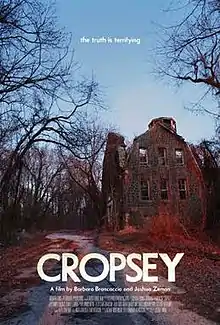Cropsey (film)
Cropsey is a 2009 American documentary film written and directed by Joshua Zeman and Barbara Brancaccio. The film initially begins as an examination of "Cropsey", a boogeyman-like figure from New York City urban legend, before segueing into the story of Andre Rand, a convicted child kidnapper from Staten Island.
| Cropsey | |
|---|---|
 Theatrical release poster | |
| Directed by | Joshua Zeman Barbara Brancaccio |
| Produced by | Joshua Zeman Barbara Brancaccio Zachary Mortensen |
| Written by | Joshua Zeman |
| Music by | Alexander Lasarenko |
| Cinematography | Chad Davidson |
| Edited by | Tom Patterson |
Production company | |
| Distributed by | Cinema Purgatorio (theatrical) Breaking Glass Pictures (2011, DVD) |
Release date |
|
Running time | 84 minutes |
| Country | United States |
| Language | English |
In 2009, Cropsey premiered at the Tribeca Film Festival, where programmer David Kwok stated; “the eeriness of the mystery pulsates through the film as they journey into the underbelly… as more information and clues unravel, Zeman and Brancaccio become more immersed in shocking surprises and revelations. The reality they uncover in this uniquely hair-raising documentary is more terrifying than any urban legend.”[1]
Production
Upon shooting their research of the origins of the missing children's stories, Zeman and Brancaccio realized the truth did not dwindle into something concrete; instead, it expanded into something larger and convoluted, becoming an in depth investigation of five missing children’s stories. The objective was to bring the distinct elements into one overarching narrative: the oral tradition of urban legends; the mystery of the missing children; the courtroom drama; the search for the roots of Staten Island’s obsession with the case, the community’s need for catharsis.
When filming began, Zeman and Brancaccio sent Andre Rand a letter. After not receiving a response for approximately a month, they decided to visit him directly at Rikers Island. On the day they were going to Rikers, they received the reply. After a series of letter exchanges, Rand agreed to an interview. However, by the time the filmmakers arrived at the prison, Rand had changed his mind and declined.
Andre Rand’s court case did not start until four years after his indictment, which was one of the longest pre-trial motions in New York State history. The culmination of the film alludes to indicting Rand, which became controversial.
Reception
On review aggregator Rotten Tomatoes, Cropsey holds an approval rating of 91%, based on 44 reviews, and an average rating of 7.2/10. It's consensus reads, "Riveting and bone-chillingly creepy, Cropsey manages to be one of the best documentaries and one of the best horror movies of the year."[2] On Metacritic, the film has a weighted average score of 73 out of 100, based on 14 critics, indicating "generally favorable reviews".[3]
Film critic Roger Ebert gave the film three out of four stars, writing, "Cropsey is a creepy documentary with all the elements of a horror film about a demented serial killer, and an extra ingredient: This one is real."[4] Jeannette Catsoulis of The New York Times called it "Disturbing and flavorful", praising the film's use of archival footage, interviews, and "true-crime narrative".[5] Noel Murray from The A.V. Club wrote, "Cropsey is compelling as a meditation on how we use stories to explain the inconceivable, and how if no story is handy, we take the available clues and make one up."[6] J.R. Jones from The Chicago Reader praised the film as "disturbing", and praised the filmmakers exploration behind the real life inspiration behind the urban legend.[7] Cynthia Fuches of PopMatters rated the film seven out of ten stars, offering the film similar praise as well is its storytelling and investigation aspects.[8]
The film was not without its detractors. Slant Magazine's Nick Schager awarded the film two out of four stars, writing, "Zeman’s portentous, trailer-ready narration and the film’s correspondingly manipulative horror-film aesthetics and fondness for creepy suggestions over vigorous journalism, typified by a wannabe-Zodiac “You decide!” ending, turns what might have been a portrait of the boogeyman myth’s lingering societal role into merely a crude episode of 48 Hours."[9]
See also
- The Burning (film), a 1981 horror film based on the urban legend of Cropsey
- Madman (1982 film), a 1982 horror film based on the urban legend of Cropsey
References
- Kwok, David (June 5, 2010). "Cropsy, Tribeca Film Festival". Tribeca Film Festival Guide. Archived from the original on June 5, 2010.
- "Cropsey (2010) – Rotten Tomatoes". Rotten Tomatoes.com. Fandango Media. Retrieved 2 October 2019.
- "Cropsey reviews". Metacritic. CBS Interactive. Retrieved 2 October 2019.
- Ebert, Roger. "Cropsey movie review & film summary (2010)". RogerEbert.com. Roger Ebert. Retrieved 2 October 2019.
- Catsoulis, Jeannette. "Joshua Zeman and Barbara Broncaccio Look at Kidnappings - The New York Times". NYTimes.com. Jeannette Catsoulis. Retrieved 2 October 2019.
- Murray, Noel. "Cropsey". AVClub.com. Noel Murray. Retrieved 2 October 2019.
- Jones, J. "Cropsey". ChicagoReader.com. J.R. Jones. Retrieved 2 October 2019.
- Fuches, Cynthia. "'Cropsey': You Hear Stories - PopMatters". PopMatters.com. Cynthia Fuches. Retrieved 2 October 2019.
- Schager, Nick. "Review: Cropsey - Slant Magazine". SlantMagazine.com. Nick Schager. Retrieved 2 October 2019.
- "Hammer to Nail" (PDF). Cropsey Legend. July 8, 2011. Archived from the original (PDF) on July 8, 2011.
- "Annual Critics' Survey: 2009 Best Undistributed Film List". Indiewire. 2009.
- "Closing Night Film: Cropsey". SF Documentary Festival. Archived from the original on July 8, 2011. Retrieved July 8, 2011.
- "Awards". Staten Island Film Festival.